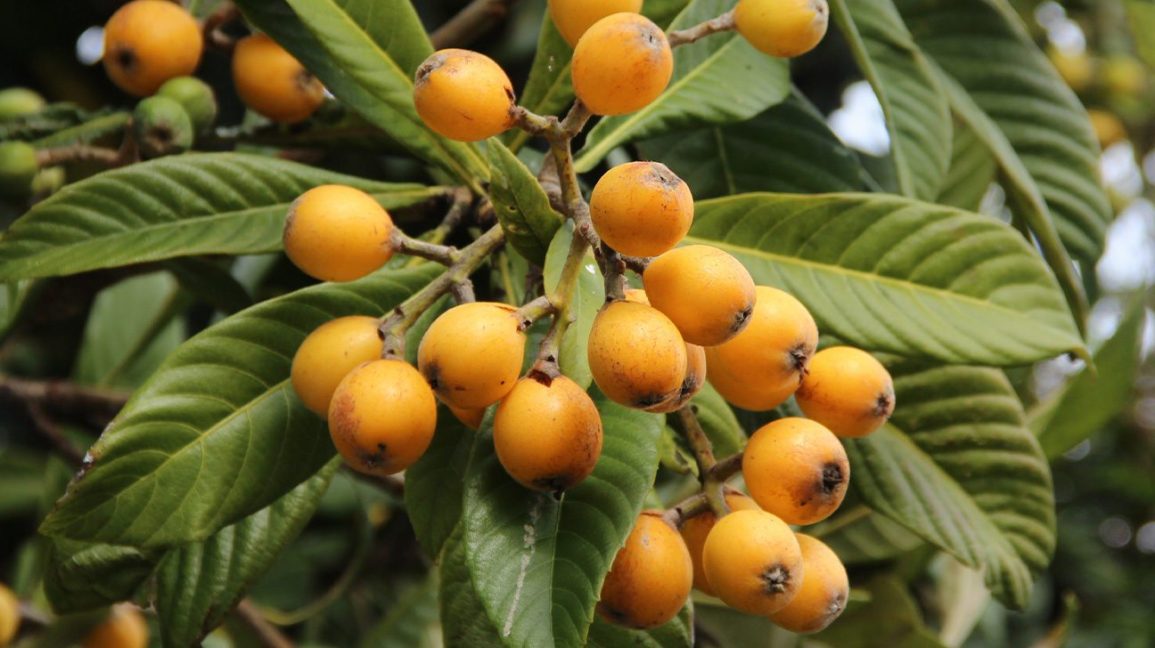
Growing food, whether fruit or veggies, is not the easiest thing to do. But some types are easier to grow than others. It’s so important to set small, achievable goals when taking on a challenging new project like learning to grow your own food. By starting small, with easy-to-grow trees, you can build confidence and the skills you will need to succeed at this rewarding pursuit. If you’re a garden novice but want to grow fruit, consider starting off with one of these user friendly fruit trees.
Loquat
Deliciously sweet-tart fruits are oval, rounded, or pear-shaped and range from 1”-2” long. The juicy fruits are typically yellow to orange in color. The fleshy fruits have a few large smooth seeds in the center which are easily removed. Take a small bite off the bottom of the fruit, then squeeze the top to eject the seeds. The fruits ripen in late winter to early spring. Loquat fruit is a real treat to eat fresh, but it can also be processed in jams, jellies, or fruit leather. The leaves are used to make a mild, tasty tea that is said to have medicinal properties.
Loquats are well-known in parts of Asia, but are almost never seen in American grocery stores. The evergreen trees are lovely, useful and ornamental in their own right. Fast-growing evergreen plants reach 15’-20’ tall & wide. They have large, dark green leaves that lend a tropical feel to your landscape. Their fast growth makes them very useful as a screening plant when you need a large visual block.
Loquats need only basic care to thrive in the Tallahassee area. Loquats do not require special pruning and they have no common pest or disease issues. Plant them in full sun to partial sun. Give them plenty of mulch and water, and be sure to fertilize once or twice a year. Loquats set fruit best when they are planted together, plant at least 2 trees for best fruiting. That should do it! A really happy Loquat can produce fruit in as little as 1-2 years.
Dwarf Everbearing Mulberry
Mulberries are another fruit that most Americans have never tasted, which is a real shame! The Dwarf Everbearing Mulberry produces small, black berries, about the size of a blueberry. The juicy fruits have a lovely balance of sweet and tart. There are other mulberry varieties that produce larger fruits, but those plants also grow much bigger (40’ tall or more). Dwarf Everbearing is easy for the home gardener as it only grows 12’-15’ tall.
You won’t get huge bushels of fruit off of this tree, but the handfuls you will harvest are uniquely delicious. Plus, you will feed lots of birds who love the small berries. I should also say, Dwarf Everbearing may be the single easiest fruit tree to grow. Planted in full sun or partial sun, it needs only the most basic of care to grow rapidly and fruit each year. Plant this tree with lots of compost, mulch it heavily, and try to remember to water it. My specimens of this variety have survived on little more than that for years. Of course, if you fertilize and water regularly your plants will grow even faster and produce even more fruit.
Dwarf Everbearing is so reliable and often fruits in the first or second year. It is a great choice to plant with kids because of the quick results and fun, kid-sized fruit. They require no special pruning and they have no serious pest or disease issues. This variety does not require a pollinator and can be planted by itself.
Fig
Figs are a bit more widely known, but I am still surprised how many people haven’t eaten them. Figs range from golf ball to tennis ball size and come in brown, purple, and green ripening varieties. The soft flesh ranges from pleasantly sweet and flavorful, to intense pure sugary syrup sweetness! I love a ripe fig on a hot summer day. I mean it is seriously incredible. Figs are ideal for fresh eating, but they also make amazing jams, jellies, and syrups.
Fig trees usually grow like a large bush with many branches. They create wide, rounded canopies that rarely top 8’-12’ tall in our region, so they are easy to pick from the ground. Figs love organic matter in the soil. Add lots of compost when you plant them and maintain a wide, deep ring of mulch around the plants. They are very drought tolerant once they are established but benefit from watering if it hasn’t rained in a while. Fertilize just once per year in spring.
Figs are prone to some leaf diseases by the end of summer, but it is more unsightly than an actual problem. Figs are deciduous and drop their leaves come winter anyways. Healthy figs can bear fruit in 2-3 years, and they really will thrive with just full sun, mulch, compost, water, and a bit of fertilizer. Figs do not require special pruning and they have no serious pest or disease problems. All the figs we carry at Tallahassee Nurseries are self-fertile and do not need to be planted with a pollinator.
Mayhaw
Southerners love that Mayhaw jelly! It’s the glowing, neon red jelly you find at good country stores and it’s made from Mayhaw berries. Mayhaw fruits look like glossy, bright red crabapples. They have a porous, pithy flesh that is best for cooking, not fresh eating. Fresh fruits are rather tart with a flavor like cranberry apple. If you grow Mayhaws and make jelly, you’ll make very good friends with anyone you gift a jar to. This video will show you how some North Florida experts make their jelly: https://goldenacresranchflorida.com/mayhaw-berry-trees/jelly-making-videos/
The plants are attractive small trees that produce a stunning, though short-lived, crop of white flowers each spring. The deciduous native trees are best planted in full sun. They are a great food source for pollinators and other wildlife. The red berries ripen in summer and are harvested off the ground after shaking the tree or smacking the branches with a pole. No special pruning is required and the native plants have no major pest or disease problems. Expect Mayhaws to fruit in 4-5 years, though you may see a few fruits sooner than that. Mayhaws do require multiple trees to produce fruit. Plant 3 or more varieties near each other for good fruit production.
Citrus
Everybody knows about citrus, and surely has a favorite. I’m partial to those sweet sweet sweet satsumas that ripen in November, but we can grow lemons, limes, oranges, and grapefruit here too. Citrus plants are evergreens that like warm weather. There are plenty of varieties that will survive our winters, but some consideration should go into where you plant citrus to give it protection from freezing weather. We have an in depth citrus growing guide if you want all the details: https://www.tallahasseenurseries.com/growing-citrus-north-florida/
I think citrus deserves to be in this “easiest fruit” category because I’ve seen so many people have success with them. However, they do have slightly greater care needs than the other options I’ve discussed. The basic care of mulch, water, and fertilizer will likely give you strong and productive citrus plants, but they are less forgiving of error. You really can’t forget about young citrus plants for their first few years or they will become stunted and possibly die.
Young citrus like to be fertilized every 6-8 weeks from February-September, you should make sure the soil stays well-watered, and keep a wide ring of mulch around the trees. If you do that, and keep up with it, you’ll be golden. If you fail to fertilize or water, you will not have a good time. Citrus can begin to fruit well in 3-5 years, though a few fruits may form much earlier. Citrus requires no special pruning, but there are a few common pest problems. Fortunately, the most common problems like Leaf Miner, Scale, and Whitefly are all easy to treat with certified organic solutions. All the citrus we carry at Tallahassee Nurseries is self-fertile and does not need to be planted with a pollinator.
*This article was written by Jonathan Burns (Tallahassee Nurseries Outdoor Manager, FNGLA Florida Certified Horticulture Professional) using information from years of personal observations growing in the Tallahassee area.
Want to learn some basics for fruit tree care? Click HERE
Growing fruit is so rewarding, but the challenge can be frustrating. This article explores a different way of thinking about growing fruit that helps make the journey more enjoyable. Click HERE to read.

